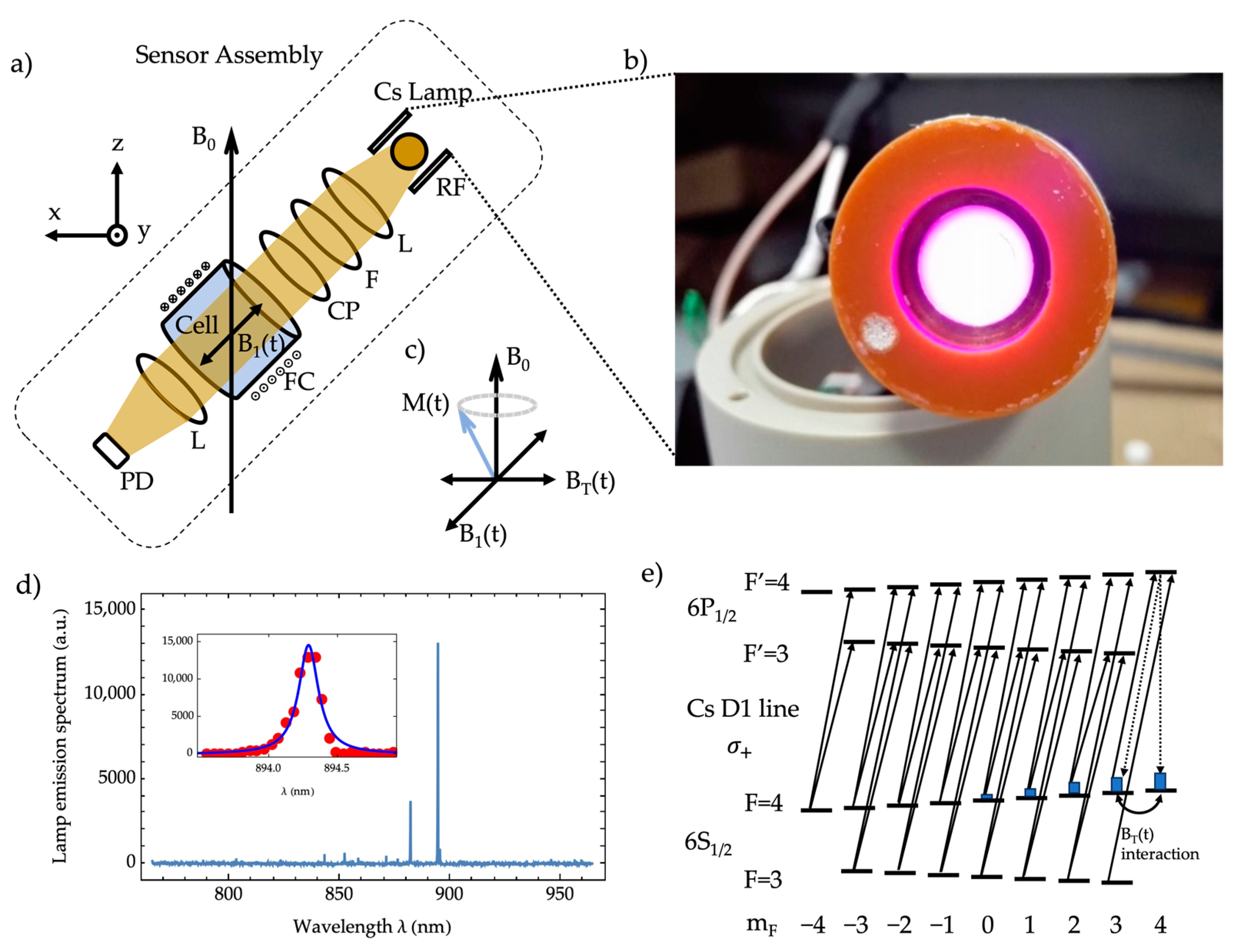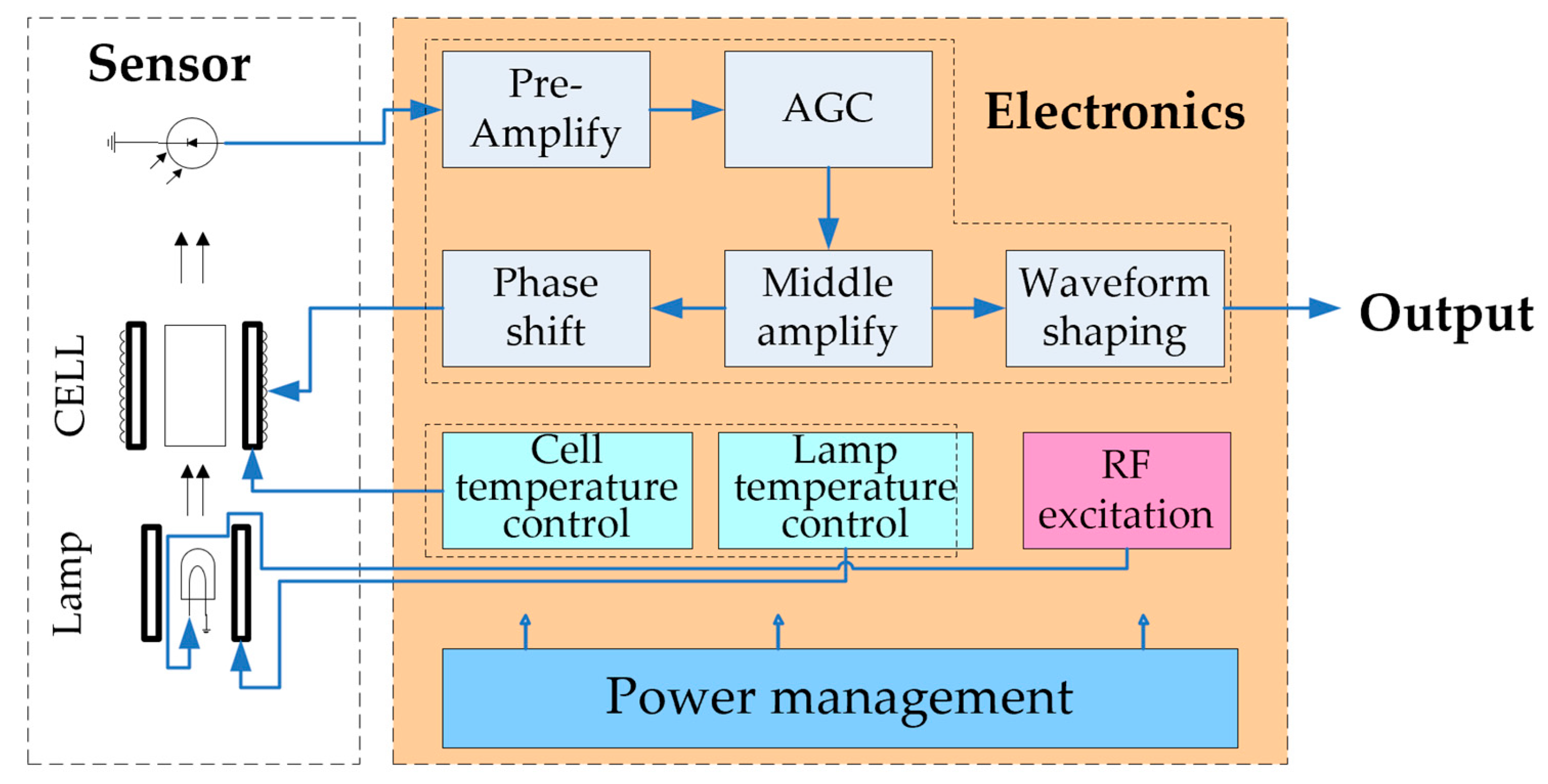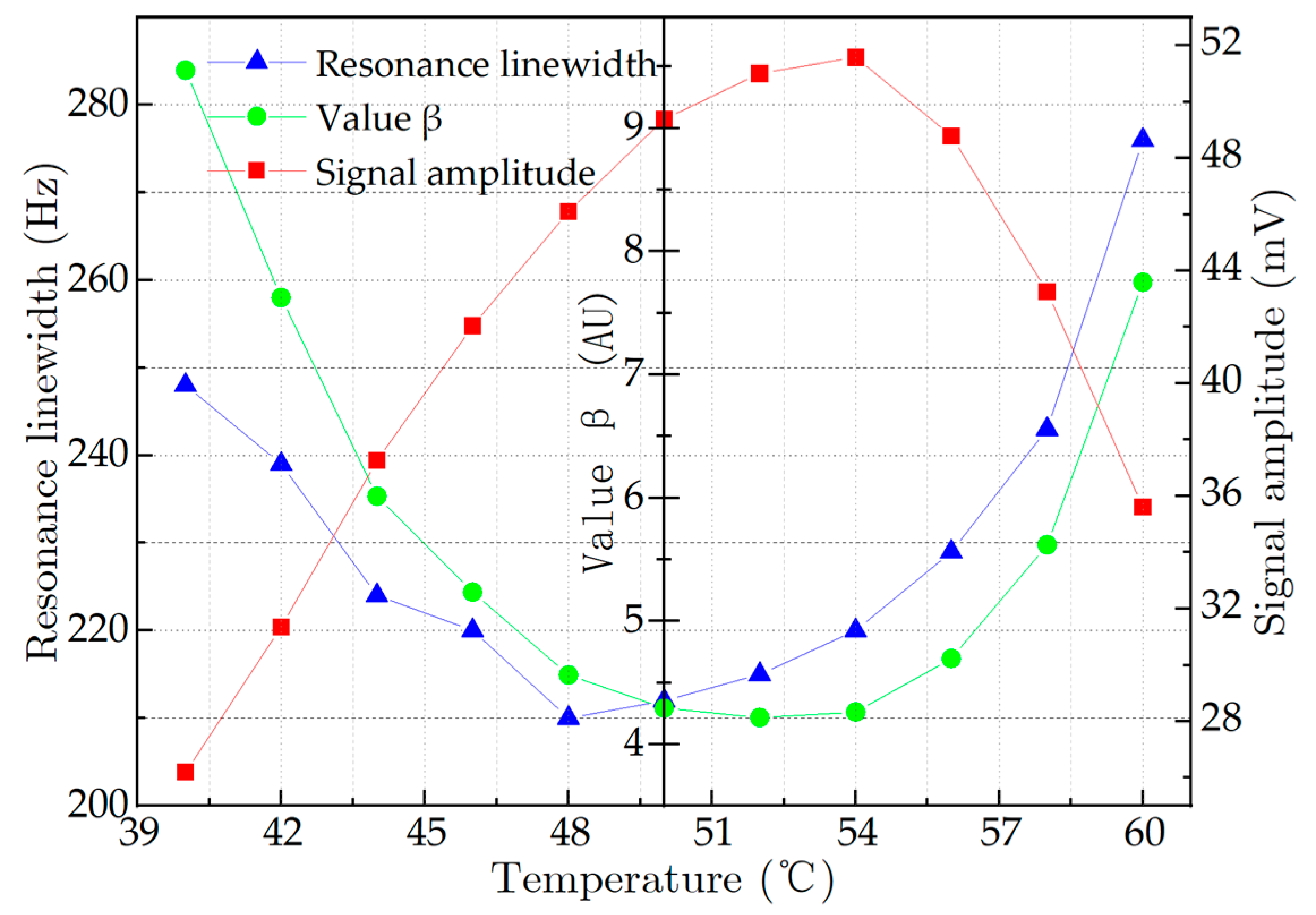A High-Sensitivity Cesium Atomic Magnetometer Based on A Cesium Spectral Lamp
Abstract
:1. Introduction
2. Design and Construction of Cesium Atomic Magnetometer
2.1. Sensor Assembly
2.2. Electronic Unit
3. Evaluation of the Intrinsic Spin Relaxation and Magnetometer’s Fundamental Quantum Limit Sensitivity
4. Optimization Processes for Improving the Magnetometer’s Sensitivity
4.1. Factors Affecting Magnetometer’s Sensitivity
4.2. Optimization of Cesium Spectral Lamp
4.3. Optimization of Magnetic Resonance Linewidth and Signal Amplitude
5. Magnetometer Testing
6. Conclusions
Author Contributions
Funding
Institutional Review Board Statement
Informed Consent Statement
Data Availability Statement
Acknowledgments
Conflicts of Interest
References
- Budker, D.; Romalis, M. Optical Magnetometry. Nat. Phys. 2007, 3, 227–234. [Google Scholar] [CrossRef] [Green Version]
- Boto, E.; Holmes, N.; Leggett, J.; Roberts, G.; Shah, V.; Meyer, S.S.; Muñoz, L.D.; Mullinger, K.J.; Tierney, T.M.; Bestmann, S.; et al. Moving Magnetoencephalography towards Real-World Applications with a Wearable System. Nature 2018, 555, 657–661. [Google Scholar] [CrossRef] [Green Version]
- Afach, S.; Budker, D.; DeCamp, G.; Dumont, V.; Grujić, Z.D.; Guo, H.; Kimball, D.F.J.; Kornack, T.W.; Lebedev, V.; Li, W.; et al. Characterization of the Global Network of Optical Magnetometers to Search for Exotic Physics (GNOME). Phys. Dark Universe 2018, 22, 162–180. [Google Scholar] [CrossRef]
- Abel, C.; Afach, S.; Ayres, N.J.; Baker, C.A.; Ban, G.; Bison, G.; Bodek, K.; Bondar, V.; Burghoff, M.; Chanel, E.; et al. Measurement of the Permanent Electric Dipole Moment of the Neutron. Phys. Rev. Lett. 2020, 124, 081803. [Google Scholar] [CrossRef] [Green Version]
- Alexandrov, E.B. Recent Progress in Optically Pumped Magnetometers. Phys. Scr. 2003, 2003, 27. [Google Scholar] [CrossRef]
- Aleksandrov, E.B.; Vershovskii, A.K. Modern Radio-Optical Methods in Quantum Magnetometry. Phys. Uspekhi 2009, 52, 573–601. [Google Scholar] [CrossRef] [Green Version]
- Feng, Y.; Zhang, Q.; Zheng, Y.; Qu, X.; Wu, F.; Fang, G. An Improved Aeromagnetic Compensation Method Robust to Geomagnetic Gradient. Appl. Sci. 2022, 12, 1490. [Google Scholar] [CrossRef]
- Chen, L.; Zhu, W.; Wu, P.; Fei, C.; Fang, G. Magnetic Anomaly Detection Algorithm Based on Fractal Features in Geomagnetic Background. J. Electron. Sci. Technol. 2019, 41, 332–340. [Google Scholar] [CrossRef]
- Zheng, Y.; Li, S.; Xing, K.; Zhang, X. A Novel Noise Reduction Method of UAV Magnetic Survey Data Based on CEEMDAN, Permutation Entropy, Correlation Coefficient and Wavelet Threshold Denoising. Entropy 2021, 23, 1309. [Google Scholar] [CrossRef]
- Mamouch, Y.; Attou, A.; Miftah, A.; Ouchchen, M.; Dadi, B.; Moussaid, A.; Et-tayea, Y.; El Azmi, M.; Boualoul, M. Aeromagnetic Data of the Kelâat M’Gouna Inlier (Jbel Saghro, Eastern Anti-Atlas, Morocco): Geotectonic and Mining Implications. J. Afr. Earth Sci. 2023, 197, 104744. [Google Scholar] [CrossRef]
- Bloom, A.L. Principles of Operation of the Rubidium Vapor Magnetometer. Appl. Opt. 1962, 1, 61–68. [Google Scholar] [CrossRef]
- Geometrics, Inc. G-824A Cesium Magnetometer Operation Manual. Available online: https://www.geometrics.com/wp-content/uploads/2018/10/824AManual_rev8.pdf (accessed on 30 June 2023).
- Quspin, Inc. QTFM. Available online: https://quspin.com/qtfm/ (accessed on 30 June 2023).
- Liu, L.; Lu, Y.; Zhuang, X.; Zhang, Q.; Fang, G. Noise Analysis in Pre-Amplifier Circuits Associated to Highly Sensitive Optically-Pumped Magnetometers for Geomagnetic Applications. Appl. Sci. 2020, 10, 7172. [Google Scholar] [CrossRef]
- Limes, M.E.; Foley, E.L.; Kornack, T.W.; Caliga, S.; McBride, S.; Braun, A.; Lee, W.; Lucivero, V.G.; Romalis, M.V. Portable Magnetometry for Detection of Biomagnetism in Ambient Environments. Phys. Rev. Appl. 2020, 14, 011002. [Google Scholar] [CrossRef]
- Oelsner, G.; IJsselsteijn, R.; Scholtes, T.; Krüger, A.; Schultze, V.; Seyffert, G.; Werner, G.; Jäger, M.; Chwala, A.; Stolz, R. Integrated Optically Pumped Magnetometer for Measurements within Earth’s Magnetic Field. Phys. Rev. Appl. 2022, 17, 024034. [Google Scholar] [CrossRef]
- Sutter, J.U.; Lewis, O.; Robinson, C.; McMahon, A.; Boyce, R.; Bragg, R.; Macrae, A.; Orton, J.; Shah, V.; Ingleby, S.J.; et al. Recording the Heart Beat of Cattle Using a Gradiometer System of Optically Pumped Magnetometers. Comput. Electron. Agric. 2020, 177, 105651. [Google Scholar] [CrossRef]
- Fu, K.-M.C.; Iwata, G.Z.; Wickenbrock, A.; Budker, D. Sensitive Magnetometry in Challenging Environments. AVS Quantum Sci. 2020, 2, 044702. [Google Scholar] [CrossRef]
- Liu, J.; Jing, D.-Y.; Wang, L.; Li, Y.; Quan, W.; Fang, J.; Liu, W.-M. The Polarization and the Fundamental Sensitivity of 39K (133Cs)-85Rb-4He Hybrid Optical Pumping Spin Exchange Relaxation Free Atomic Magnetometers. Sci. Rep. 2017, 7, 6776. [Google Scholar] [CrossRef] [Green Version]
- Liu, J.; Jing, D.-Y.; Zhuang, L.; Quan, W.; Fang, J.; Liu, W.-M. Polarization and Fundamental Sensitivity of 39K (133Cs)–85Rb–21Ne Co-Magnetometers. Chin. Phys. B 2020, 29, 043206. [Google Scholar] [CrossRef]
- Seltzer, S.J. Developments in Alkali-Metal Atomic Magnetometry. Ph.D. Thesis, Princeton University, Princeton, NJ, USA, 2008. [Google Scholar]
- Franz, F.A.; Sooriamoorthi, C.E. Spin relaxation within the 62P1/2 and 62S1/2 states of cesium measured by white-light optical pumping. Phys. Rev. A 1974, 10, 126–140. [Google Scholar] [CrossRef]
- Bhaskar, N.D.; Pietras, J.; Camparo, J.; Happer, W.; Liran, J. Spin Destruction in Collisions between Cesium Atoms. Phys. Rev. Lett. 1980, 44, 930–933. [Google Scholar] [CrossRef]
- Ishikawa, K.; Anraku, Y.; Takahashi, Y.; Yabuzaki, T. Optical Magnetic-Resonance Imaging of Laser-Polarized Cs Atoms. J. Opt. Soc. Am. B 1999, 16, 31–37. [Google Scholar] [CrossRef]
- Beverini, N.; Minguzzi, P.; Strumia, F. Foreign-Gas-Induced Cesium Hyperfine Relaxation. Phys. Rev. A 1971, 4, 550–555. [Google Scholar] [CrossRef]
- Grujić, Z.D.; Koss, P.A.; Bison, G.; Weis, A. A Sensitive and Accurate Atomic Magnetometer Based on Free Spin Precession. Eur. Phys. J. D 2015, 69, 135. [Google Scholar] [CrossRef]
- Groeger, S.; Pazgalev, A.S.; Weis, A. Comparison of Discharge Lamp and Laser Pumped Cesium Magnetometers. Appl. Phys. B 2005, 80, 645–654. [Google Scholar] [CrossRef] [Green Version]
- Jimenez-Martinez, R.; Griffith, W.C.; Wang, Y.-J.; Knappe, S.; Kitching, J.; Smith, K.; Prouty, M.D. Sensitivity Comparison of Mx and Frequency-Modulated Bell–Bloom Cs Magnetometers in a Microfabricated Cell. IEEE Trans. Instrum. Meas. 2010, 59, 372–378. [Google Scholar] [CrossRef]
- Shi, Y.; Scholtes, T.; Grujić, Z.D.; Lebedev, V.; Dolgovskiy, V.; Weis, A. Quantitative Study of Optical Pumping in the Presence of Spin-Exchange Relaxation. Phys. Rev. A 2018, 97, 013419. [Google Scholar] [CrossRef] [Green Version]
- Weis, A.; Bison, G.; Grujić, Z.D. Magnetic Resonance Based Atomic Magnetometers. In High Sensitivity Magnetometers; Grosz, A., Haji-Sheikh, M., Mukhopadhyay, S., Eds.; Smart Sensors, Measurement and Instrumentation Series; Springer: Cham, Switzerland, 2017; pp. 361–424. ISBN 978-3-319-34070-8. [Google Scholar] [CrossRef]
- Ren, C.; Duan, M.; Zhi, X. Characteristics of extreme surface air temperature in winter and summer over China under different climate backgrounds. Trans. Atmos. Sci. 2017, 40, 803–813. [Google Scholar]
- Steck, D.A. Cesium D Line Data. Available online: http://steck.us/alkalidata (accessed on 21 November 2019).
- Formichella, V.; Camparo, J.; Tavella, P. Mitigation of Lamplight-Induced Frequency Jumps in Space Rubidium Clocks. IEEE Trans. Ultrason. Ferroelectr. Freq. Control 2018, 65, 911–918. [Google Scholar] [CrossRef] [PubMed]














| State | RF Frequency | RF Output Power | Optical Power |
|---|---|---|---|
| Before Improvement | 0.80% | 61.97% | 42.92% |
| After Improvement | 0.07% | 2.05% | 14.68% |
Disclaimer/Publisher’s Note: The statements, opinions and data contained in all publications are solely those of the individual author(s) and contributor(s) and not of MDPI and/or the editor(s). MDPI and/or the editor(s) disclaim responsibility for any injury to people or property resulting from any ideas, methods, instructions or products referred to in the content. |
© 2023 by the authors. Licensee MDPI, Basel, Switzerland. This article is an open access article distributed under the terms and conditions of the Creative Commons Attribution (CC BY) license (https://creativecommons.org/licenses/by/4.0/).
Share and Cite
Lu, Y.-T.; Liu, L.-S.; Shi, Y.-Q.; Zhao, T.; Zhu, W.-H.; Zhang, T.-F.; Liu, W.-M.; Zhang, X.-J. A High-Sensitivity Cesium Atomic Magnetometer Based on A Cesium Spectral Lamp. Appl. Sci. 2023, 13, 8225. https://doi.org/10.3390/app13148225
Lu Y-T, Liu L-S, Shi Y-Q, Zhao T, Zhu W-H, Zhang T-F, Liu W-M, Zhang X-J. A High-Sensitivity Cesium Atomic Magnetometer Based on A Cesium Spectral Lamp. Applied Sciences. 2023; 13(14):8225. https://doi.org/10.3390/app13148225
Chicago/Turabian StyleLu, Yuan-Tian, Lei-Song Liu, Yong-Qi Shi, Tian Zhao, Wan-Hua Zhu, Tie-Fu Zhang, Wu-Ming Liu, and Xiao-Juan Zhang. 2023. "A High-Sensitivity Cesium Atomic Magnetometer Based on A Cesium Spectral Lamp" Applied Sciences 13, no. 14: 8225. https://doi.org/10.3390/app13148225






